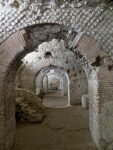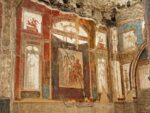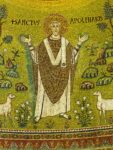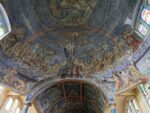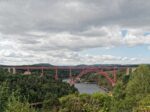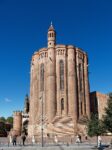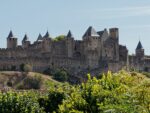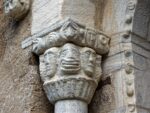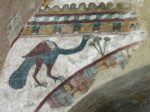These are two comprehensive sets of photographs
Naples, Herculaneum and Ravenna – Italy June 2024 and A visit to Pyrénées-Orientales southwest France
Lists of the individual photograph sets are at the bottom of the newsletter
The printable PDF version is E2E2024no2.pdf (seven A4 pages)
“But you’re never here!” exclaimed our neighbour Daniele who, together with her husband, keeps an eye on our house when we are away. I had just mentioned that we would be leaving on one of our three trips this summer. However, she would be the first to concede that the weather here has not been inspiring this summer.
 Take the first day of June. When we felt like a walk between heavy rain showers it was a question of selecting the least muddy and slippery track, but we still got soaked. The next day was so wet that we did not even venture out to see if any stall-holders had bothered to set up on the former football pitch for the Entre-deux-Eaux flea market. At least it was fine the following weekend for the Anould flea market, where we could have bought a paint-splashed ceramic bulldog for the garden. We didn’t. We have enough wild life in the garden.
Take the first day of June. When we felt like a walk between heavy rain showers it was a question of selecting the least muddy and slippery track, but we still got soaked. The next day was so wet that we did not even venture out to see if any stall-holders had bothered to set up on the former football pitch for the Entre-deux-Eaux flea market. At least it was fine the following weekend for the Anould flea market, where we could have bought a paint-splashed ceramic bulldog for the garden. We didn’t. We have enough wild life in the garden.
Encouraged by the rain, quantities of enormous snails sped along the terrace when not lurking under plants, while an even greater number of insolently gross slugs feasted on rhubarb leaves, courgette stems, sodden strawberries and anything else in the garden that had not been washed away. One night some boars started scuffing up the turf outside, but must have got interrupted before they did much damage. When Daniele’s husband discovered that the headlight wires of her car had been chewed through, probably by stone martens, 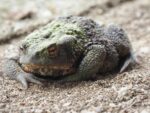 John looked under Bluto’s bonnet and found that some of the wadding had also been consumed, so hastily ordered alarms for both cars to scare the martens. Meanwhile a toad was impeding Snowy from getting in and out of the garage, having taken up residence dangerously close to the wheels. But sadly, although the female kestrel was still sitting half-heartedly and part-time on her eleven eggs at the end of June when we returned from our Italian holiday (below), it was well after the time that any could have hatched, so John decided to remove them. We lamented the lack of kestrel chicks. But apart from them, − we had quite enough wild life.
John looked under Bluto’s bonnet and found that some of the wadding had also been consumed, so hastily ordered alarms for both cars to scare the martens. Meanwhile a toad was impeding Snowy from getting in and out of the garage, having taken up residence dangerously close to the wheels. But sadly, although the female kestrel was still sitting half-heartedly and part-time on her eleven eggs at the end of June when we returned from our Italian holiday (below), it was well after the time that any could have hatched, so John decided to remove them. We lamented the lack of kestrel chicks. But apart from them, − we had quite enough wild life.
So, given the poor weather and poor crops, we had no great incentives to spend all our summer in Entre-deux-Eaux. Among the TV programmes we had enjoyed on wet evenings were those on the recent excavations at Pompeii. John had long wanted to visit more of Italy, so we chose Naples as our first destination. We booked a flight from Basel to Naples on 13th June together with rooms in an apartment between the historic centre and the railway station on the busy Corso Umberto I. Our host was very welcoming, gave us local information over coffee and immediately insisted on taking John for a short walk round the neighbourhood, pointing out churches, restaurants and hospitals while Helen put her feet up, recovering from the unaccustomed heat.
During our week in Naples we felt no urge to rush around in the heat. So we’d have a leisurely coffee and pasticcini outside a cafe, then wander round the narrow streets and into the cool of churches looking at mosaics and frescoes. There was so much to see on the surface that it took a while to realize how much could still be seen below the surface of Naples from Roman times. One day we followed an enthusiastic historian along the Roman market streets below St Lorenzo Maggiore church, seeing the slabs on which fish were sold and the walls of a tavern, laundry, bakery and dyer’s before violent floods left them covered in solidified mud at the end of the fifth century.
We spent most of one day in the Archaeological Museum seeing the early finds from Pompeii and Herculaneum.
So it was with regret, as the temperature went above 30°C that we decided that spending a day trekking round Pompeii with no shade would be foolish. But we did catch a train out to Herculaneum which is smaller and has some shade from its two-storey buildings, and found it fascinating.
As you can imagine, Naples being on the coast, we ate a lot of fish and seafood in various local trattoria in the evenings, though didn’t join the long queues just round a corner from our apartment for the best (allegedly) take away pizzas.
From Naples, we caught trains north to Ravenna. Helen had been presented with a large illustrated book on the Ravenna mosaics when she left school, but those 1960s illustrations did not do justice to the stunning mosaics we saw all these years later. It was great to have the Unesco World Heritage churches/baptistries Arian Baptistery, Basilica San Vitale, Basilica of Sant’Apollinare Nuovo, Battistero Neoniano, Capella di San Andreas, Domus del Tappeti di Petra, and Mausoleo di Galla Placidia within easy walking distance of our hotel apart from Sant’ Apollinare in Classe, a bus trip away. We missed the exuberance of Naples, but enjoyed the refined splendours and clean, quiet streets of Ravenna. We also missed our energetic Naples host, in our impersonal hotel. But there was a lively covered food market and we found the restaurant Osteria del Tempo Perso, just round the corner from our hotel, which we liked so much that we ate there most evenings.
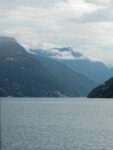 We had originally thought we might go on to Padua and Verona, but, after John pulled a back muscle in Ravenna, we decided to content ourselves with what we’d already seen. We also wanted to travel home on the scenic train line through the old Gotthard tunnel (which was currently in operation on week days because of blockages on the faster new lower route). So we caught trains from Ravenna to Bologna and Milan and then to Zurich. What scenery between Milan and Zurich – lakes, one of which our railway line crossed, churches, bell towers, tunnels, waterfalls, more tunnels, snaking rails, funiculars, vines, snowy peaks, wooden chalets, steep terraces, and after the descent, marinas and sailboards. After those views, the Zurich to Basel train and our drive over the col to Entre-deux-Eaux seemed tame.
We had originally thought we might go on to Padua and Verona, but, after John pulled a back muscle in Ravenna, we decided to content ourselves with what we’d already seen. We also wanted to travel home on the scenic train line through the old Gotthard tunnel (which was currently in operation on week days because of blockages on the faster new lower route). So we caught trains from Ravenna to Bologna and Milan and then to Zurich. What scenery between Milan and Zurich – lakes, one of which our railway line crossed, churches, bell towers, tunnels, waterfalls, more tunnels, snaking rails, funiculars, vines, snowy peaks, wooden chalets, steep terraces, and after the descent, marinas and sailboards. After those views, the Zurich to Basel train and our drive over the col to Entre-deux-Eaux seemed tame.
While we were away, our postal votes for the UK elections had arrived, so, due to changes for overseas residents, we were able to vote in the UK elections though still not in the French ones which Macron had called in a fit of pique and must have been regretting ever since. Our Grand Est region predictably voted out a good representative in favour of a Rassemblement National (formerly Front National) candidate.
Over in the UK other changes were afoot. Toby and Rachel had found a large old house they liked in a village outside Melton Mowbray. Moving there from Letchworth would mean they could see much more of Jacob who lives in Melton Mowbray with Stella, and moving in early August would be less disruptive for Farrah between her GCSEs and college. So, after three and a half weeks back in Entre-deux-Eaux, our second trip was to Letchworth, with our neighbour’s “but you’re never here!” ringing in our ears.
Our intentions of helping Toby and Rachel before the move were foiled when, one after the other, they and Farrah went down with Covid. But they were no longer infectious on 1st August, the day of the move, so we drove Rachel up to the new house which was in need of cleaning whilst Toby supervised the loading of the removal vans. As we drove into their new village we were aware of a small camera crew a few doors from their new house; one of these move-to-the-country television programmes was showing their clients the converted chapel and offered to interview Rachel, about her move to the village. Sadly she declined the moment of fame and got on with cleaning. The house has an imposing Georgian frontage, but parts look much older. With its various additions over the ages, it is on different levels, and includes partly converted farm outbuildings at the rear. This century, after being a loved family home, the next owner neglected it, so there is work to be done on the damp walls and the roof, but Toby and Rachel were looking forward to renovating it. When we returned three days later, it was a hive of activity. Toby was uprooting bushes, tall weeds and grass at the front to uncover the water meter and remove soil and plants against the damp kitchen wall, Rachel was sorting out the utility room, fridge-freezer and pantry, and Jacob and Farrah were screwing together new IKEA furniture in their bedrooms. Together with Leila we gave a hand and enjoyed a buffet lunch together in their huge kitchen. While we were in Letchworth we also caught up with friends, usually over meals, and we celebrated Ann and Derek’s birthdays. Ann’s was special as it was her 70th but she insisted it should also be a celebration of our 50th wedding anniversary which had somehow crept up on us.
The date of our return to Entre-deux-Eaux in mid-August was dictated by the rheumatologist in Luneville. We have unfortunately reached to stage where holidays have to be arranged between increasingly hard-to-get medical appointments, though we are keen to continue to travel for as long as we can. Our summer surge of trips was more enjoyable because John was pain free due to the corticosteroids our locum had prescribed for his painful joints. However the rheumatologist has been unable to provide a diagnosis while the corticosteroids mask the problem, so John has been reducing them at a programmed rate and is due to return to her in January. It used to be easy to book a cardiology appointment, but, as the number of doctors declines, Helen’s next one is in March 2025!
There are delays in supplying new cars as well as getting medical appointments. Just before we had left for Letchworth, we had a problem with one of Bluto’s brake callipers, which had left John driving very slowly and cautiously back home from the supermarket. Mme Laine’s grandsons had repaired it at their small garage down our road, but after twenty years, it felt time to think about a replacement car, this time a hybrid, most likely Toyota’s new Yaris Cross. So, after our return from Letchworth, we went over to the Toyota dealership in Epinal and had an initially useful discussion and test drive (reassuring for Helen who had never driven an automatic). However a new Yaris Cross would not be available for delivery for three months or more. Annoyingly Toyota (like many other brands) only deliver cars with summer tyres to showrooms. But the French Loi Montagne stipulates we would need non-summer tyres from 1st November to 31st March. To change to all-season tyres in order to drive home from the showroom legally would add over 900 euros to the car’s price (if the dealer changed them, or a bit less elsewhere) and we would be left with a useless set of summer tyres for which there seems to be no significant market. This is a problem in Germany and elsewhere too. Stalemate.
One morning towards the end of August, when John was in Saint-Dié and Helen was outside cutting back brambles, the commune van stopped outside. Reading the water meters once a year is one of the many responsibilities of Mickael, the commune employee (who is currently single handed as no young people have coped for long with the job of assistant, with all its outdoor tasks like verge cutting, ditching, logging of communal wood, gritting in icy weather, snow ploughing). He had come early to us knowing we are often away in September. And it was lucky he did, as, when he descended the steep cellar steps in the farmhouse, he found a leak where the water meter connected to our house plumbing. He obligingly went off to get his tools and repaired it immediately (the council had replaced the meter a few years ago). Our water bill will be considerably more this year. No sooner had Mickael departed than there was another ring at the doorbell: two muscular young men delivering our new, larger television. We were glad of their muscles, as after carrying it upstairs to our sitting room they also took away the oldest TV set, a very bulky 24” cathode ray tube one, which was up the steep stairs in the farmhouse. We just had time to shower and have lunch before it was time for a more sedate afternoon of English conversation practice with Ghislaine.
Meanwhile, with a gap in medical appointments in mid-September, we had started firming up on plans to finally visit our friend Val in the Pyrenees-Orientales. We had forgotten how long ago she had bought her second home in a small village south-west of Perpignan but she later told us that it was thirty two years ago while she was working with the British Council in Egypt. And in all those years we had never visited her part of France, but had met up with her in England. Two old Michelin Guides that we had picked up at the Amnesty Book Sale in Saint-Dié in February (previous newsletter) aided our planning (after all, the interesting monuments do not change, even if visiting hours do). John was keen to see the Millau Viaduct and Helen to see Carcassonne en route.
We set out driving on this third summer jaunt on a horrid wet day and spent the first night in Vichy. Next morning, after a quick walk round Vichy’s imposing art nouveau and art deco buildings including Saint Blaise and Notre Dame des Malades church (whose unusual art deco interior Helen found grey and oppressive), we drove on motorways towards Clermont Ferrand, past puys and through dramatic gorges, pausing to gaze from a distance at Gustave Eiffel’s Garabit railway viaduct, before reaching the more recent Millau Viaduct.
We got good views of it and information on its construction from the visitors’ centre, before we drove slowly across it. We turned off at the next junction and circled back till we were right underneath its soaring piles. We appreciated its height, span, grandeur and engineering achievement even more from below. We then followed small D roads along ridges to Albi where we had booked a hotel room for two nights so we could have a full day exploring the picturesque sounding mediaeval town.
We ate that evening at Opulence in the old town. After washing our hands like school children in the stone sinks by the front door, we were ushered upstairs. We ordered the surprise menu and an amazing array of all one’s favourite entrées was squeezed onto our table, with sizzling snails, garlic and parsley, and a platter of pork pie, terrine, a herby yogurt dip, humus, bread, and hard boiled eggs with a green topping. We needed our local beers to wash that lot down. The main course was varied too, with casseroles of pork, duck, octopus, vegetables and a potato, cheese and garlic aligot. The three desserts seemed tame in comparison.
Next morning we were amazed by the soaring brick walls of Albi cathedral (1282-1380) − the largest brick built cathedral in the world. After the plainness and simplicity of the brickwork outside we were unprepared for the assault of colour and detail inside, with every inch of the walls and vaulting painted in blues and golds, and a grim Last Judgement on the west walls. The adjacent brick Palace of the Bishops was a stark statement of power as if the authoritarian bishops had enclosed themselves in a fortified castle against the local consuls and inhabitants with whom they were unpopular.
As it now contains the Toulouse Lautrec Museum, we were able to walk round its palatial rooms in the afternoon, amused at one point by the exuberant Le Goulou can-can poster hung between two impassive bishops.
We had booked a pleasant spacious apartment below the walls of the fortified citadel in Carcassone for the next three nights. Perhaps it was a mistake to walk round the fifth most visited site in France on a weekend.
It was also disappointing to get little sense of the violent conflicts there between Cathars and Crusaders (especially after re-reading Kate Mosse) or indeed any of the citadel’s history before its extensive nineteenth century restoration by Viollet-le-Duc. It was near enough to our apartment for us to climb up and wander round several times during our stay, but looked at its most impressive when viewed from our kitchen window at night when the walls were illuminated.
From Carcassonne we drove down to Val’s village of Maureillas-las-Illas, stopping on the way to look round the former Cistercian Abbey of Fontfroide. Val’s house in the heart of the village is small, despite its four floors, but brimming with character, some created by Val and some by the artists who had left their painted furniture. Our Airbnb apartment just down the road from Val’s by contrast was a spacious, recent conversion. We took full advantage of its facilities, taking Val’s crockery down to our dishwasher after she’d cooked tasty meals, and she used our Wi-Fi connection as she was having problems with e-mailing.
Unlike Carcassone, the many small Romanesque churches and abbeys in the area had retained their sense of history through wars of religion, attacks, neglect after the French Revolution and even sale of their columns and capitals. We enjoyed seeing frescoes which had been uncovered (when paint layers were scraped off or the organ removed for repair) and the inventive sculpted capitals of reinstated columns.
We added two saints to our list of never-heard-of-’em saints: Saint Abdon and Saint Sennen at the Abbaye Sainte Marie in Arles-sur-Tech. The sarcophagus containing their relics filled miraculously each year with healing water distributed to pilgrims. The small priory of Santa Maria del Vilar, which used to shelter pilgrims on their way to Compostella, was now a Romanian Orthodox Monastery whose icons and red and gold embroidered fabrics added richness to the overhead frescoes of peacocks eating and drinking from lilies. Equally fascinating were the churches at Saint-Genis des Fontaines, Saint Andre, Elne and Sainte Eulalie Cathedral, Montesquieu des Alberes and Saint Saturnin Church.
For us, no holiday is complete without a train journey. So one morning we drove up the Têt valley to Villefranche-de Conflent. After walking round the small walled town (though not slogging up to the Vauban fort above it) and looking round the nearby small church in Corneilla de Conflent, we caught le Train Jaune (the yellow train) further up the valley. And yes, the train is yellow, and most passengers crammed into the open waggon, adding layers of clothing as temperatures dropped.
Cameras were kept busy, recording the steep-sided valley, the curving single-track line, the tiny stations and the viaducts. Later heavy rain started to fall and there was a dash to covered carriages at the next halt. Most passengers got off at St Louis, but we were pleased that we’d booked to travel on to the ski resort of Font Romeu, as the scenery turned from lush valley to arid grassland with birds of prey swooping overhead, and we passed through the highest SNCF station in France. The return train was delayed when the train in front of us broke down (failed brakes, its shivering passengers said when we eventually picked the up at a passing-point station). It was late and dark as we drove back to Maureillas.
Val was keen to take us to the Taverne de Riunoguès in the hills above Maureillas for Sunday lunch. The road was narrow and winding, and the only other buildings we saw were the tiny church and graveyard and a gîte which might once have been a school. We climbed up the narrow stone steps into a dim room where the hors d’oeuvres were laid out in a cabinet near the door, and were led through into a lighter room to our table by the window. After ordering our main course from a chalked blackboard menu and some wine, we loaded our plates with hors d’oeuvres. The main courses were equally filling – John’s an unusual combination of rabbit and snails − the cheese course generous, and the lemon meringue tart chunky (and that was without the Chantilly cream extra). A man and guitar circled the tables droning Georges Brassens and other songs of yesteryear.
A few days later we drove back through heavy rain to Entre-deux-Eaux at the end of a very enjoyable two-week holiday. The house felt cold, and John turned on the heating. As temperatures dropped down to two degrees, Helen brought the pots of geraniums and fuchsias into the barn. A few days later Helen joined the oldies of Entre-deux-Eaux on a fascinating visit to a sawmill in a nearby glacial valley, enduring the cold and crouching on logs or benches − this was after all the setting used in a famous Franco-Italian film Les Grandes Gueules.
 The Alps were this year’s invited “country” at Saint-Dié’s Festival International de Geographie (FIG) at the beginning of October. We felt the town had not wasted much money this year on an Alpine décor as we strolled round town registering the hay bales with animal ears. We had not been attracted by any of this year’s lectures. By far the busiest area was the book marquee, closely followed by the food stalls in the market place. It felt a subdued event compared with earlier years. Perhaps Saint-Dié no longer sees itself as the capitale mondiale de la Géographie. That Saturday morning we had noticed cars parked on fields and a man in a pink high-vis jacket crouching behind a hay bale in the field below our bedroom window. The hunting season had opened. The hay bales have since been gathered up and on windy days, the first leaves are swirling and skidding along the ground.
The Alps were this year’s invited “country” at Saint-Dié’s Festival International de Geographie (FIG) at the beginning of October. We felt the town had not wasted much money this year on an Alpine décor as we strolled round town registering the hay bales with animal ears. We had not been attracted by any of this year’s lectures. By far the busiest area was the book marquee, closely followed by the food stalls in the market place. It felt a subdued event compared with earlier years. Perhaps Saint-Dié no longer sees itself as the capitale mondiale de la Géographie. That Saturday morning we had noticed cars parked on fields and a man in a pink high-vis jacket crouching behind a hay bale in the field below our bedroom window. The hunting season had opened. The hay bales have since been gathered up and on windy days, the first leaves are swirling and skidding along the ground.
Summer is over and autumn has arrived.
Links to the individual sets of photographs:
Naples – Street and Everyday Scenes
Naples – Duomo and Duomo baptistry
Naples – Roman and Greek underground
Naples – Santa Clara
Naples – three churches
Naples – Street art
Herculaneum
Ravenna – Arian Baptistery
Ravenna – Basilica San Vitale
Ravenna – Basilica di Sant’Apollinare in Classe
Ravenna – Basilica of Sant’Apollinare Nuovo
Ravenna – Battistero Neoniano (Baptistero degli Ortodossi)
Ravenna – Capella di San Andreas and museo Arcivescoville
Ravenna – Domus del Tappeti di Petra
Ravenna – Mausoleo di Galla Placidia
Ravenna – around and about
Naples and Ravenna – Restaurant meals
From Ravenna to Basel
Vichy and Garabit viaduct
Millau Viaduct
Albi
Carcassonne
Le Train Jaune
Fontfroide Abbey
Collioure
Saint-Genis des Fontaines
Villefranche de Conflent and Corneilla de Conflent
Ceret
Abbaye Sainte Marie – Arles-sur-Tech
Saint Andre
Elne and Sainte Eulalie Cathedral
Montesquieu des Alberes – Saint Saturnin Church
Santa Maria del Vilar Priory

